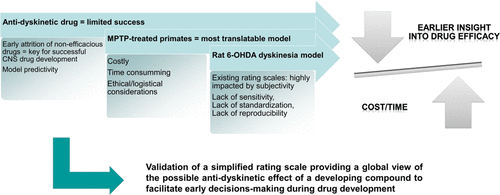当前位置:
X-MOL 学术
›
ACS Chem. Neurosci.
›
论文详情
Our official English website, www.x-mol.net, welcomes your feedback! (Note: you will need to create a separate account there.)
Validation of a New Scoring Scale for Behavioral Assessment of L-Dopa-Induced Dyskinesia in the Rat: A New Tool for Early Decision-Making in Drug Development
ACS Chemical Neuroscience ( IF 5 ) Pub Date : 2017-12-11 00:00:00 , DOI: 10.1021/acschemneuro.7b00426 Simon Loiodice 1 , Anne-Sophie Denibaud 1 , Wendy Deffains 1 , Magali Alix 1 , Pierre Montagne 1 , Marine Seffals 2 , Christophe Drieu La Rochelle 1
ACS Chemical Neuroscience ( IF 5 ) Pub Date : 2017-12-11 00:00:00 , DOI: 10.1021/acschemneuro.7b00426 Simon Loiodice 1 , Anne-Sophie Denibaud 1 , Wendy Deffains 1 , Magali Alix 1 , Pierre Montagne 1 , Marine Seffals 2 , Christophe Drieu La Rochelle 1
Affiliation

|
The 1-methyl-4-phenyl-1,2,3,6-tetrahydropyridine (MPTP)-treated nonhuman primate (NHP) has been described as the most translatable model for experimental reproduction of L-dopa-induced dyskinesia (LID). However, from a drug discovery perspective, the risk associated with investment in this type of model is high due to the time and cost. The 6-hydroxydopamine (6-OHDA) rat dyskinesia model is recommended for testing compounds but relies on onerous, and nonstandard behavioral rating scales. We sought to develop a simplified and sensitive method aiming at assessing LID in the rat. The purpose was to validate a reliable tool providing earlier insight into the antidyskinetic potential of compounds in a time/cost-effective manner before further investigation in NHP models. Unilaterally 6-OHDA-lesioned rats were administered L-dopa (20 mg/kg) and benserazide (5 mg/kg) daily for 3 weeks starting 4 weeks postlesion, then coadministered with amantadine (20–30–40 mg/kg). An adapted rating scale was used to score LID frequency and a severity coefficient was applied depending on the features of the observed behavior. A gradual increase (about 3-fold) in LID score was observed over the 3 weeks of L-dopa treatment. The rating scale was sensitive enough to highlight a dose-dependent amantadine-mediated decrease (about 2.2-fold) in LID score. We validated a simplified method, able to reflect different levels of severity in the assessment of LID and, thus, provide a reliable tool for drug discovery.
中文翻译:

行为评分的L-多巴诱发的运动障碍大鼠行为评估的新评分量表的验证:药物开发中早期决策的新工具
1-甲基-4-苯基-1,2,3,6-四氢吡啶(MPTP)处理的非人类灵长类动物(NHP)已被描述为L-多巴诱发的运动障碍(LID)实验繁殖的最可翻译的模型。但是,从药物发现的角度来看,由于时间和成本的原因,与这种类型的模型进行投资相关的风险很高。建议使用6-羟基多巴胺(6-OHDA)大鼠运动障碍模型来测试化合物,但该模型依赖于繁重的和非标准的行为评定量表。我们试图开发一种旨在评估大鼠LID的简化且灵敏的方法。目的是验证一种可靠的工具,以便在NHP模型中进行进一步研究之前,以时间/成本有效的方式更早地了解化合物的抗运动障碍潜力。从患病后4周开始,单侧对6-OHDA损伤的大鼠每天给予L-多巴(20 mg / kg)和苄丝肼(5 mg / kg)3周,然后与金刚烷胺(20–30–40 mg / kg)共同给药。根据观察到的行为特征,使用适应性评定量表对LID频率评分,并应用严重性系数。在L-多巴治疗的3周内,LID评分逐渐升高(约3倍)。评分量表足够敏感,可以突出剂量依赖性金刚烷胺介导的LID评分降低(约2.2倍)。我们验证了一种简化的方法,该方法能够反映LID评估中不同程度的严重性,从而为药物发现提供了可靠的工具。根据观察到的行为特征,使用适应性评定量表对LID频率评分,并应用严重性系数。在L-多巴治疗的3周内,LID评分逐渐升高(约3倍)。评分量表足够敏感,可以突出剂量依赖性金刚烷胺介导的LID评分降低(约2.2倍)。我们验证了一种简化的方法,该方法能够反映LID评估中不同程度的严重性,从而为药物发现提供了可靠的工具。根据观察到的行为特征,使用适应性评定量表对LID频率评分,并应用严重性系数。在L-多巴治疗的3周内,LID评分逐渐升高(约3倍)。评分量表足够敏感,可以突出剂量依赖性金刚烷胺介导的LID评分降低(约2.2倍)。我们验证了一种简化的方法,该方法能够反映LID评估中不同程度的严重性,从而为药物发现提供了可靠的工具。评分量表足够敏感,可以突出剂量依赖性金刚烷胺介导的LID评分降低(约2.2倍)。我们验证了一种简化的方法,该方法能够反映LID评估中不同程度的严重性,从而为药物发现提供了可靠的工具。评分量表足够敏感,可以突出剂量依赖性金刚烷胺介导的LID评分降低(约2.2倍)。我们验证了一种简化的方法,该方法能够反映LID评估中不同程度的严重性,从而为药物发现提供了可靠的工具。
更新日期:2017-12-11
中文翻译:

行为评分的L-多巴诱发的运动障碍大鼠行为评估的新评分量表的验证:药物开发中早期决策的新工具
1-甲基-4-苯基-1,2,3,6-四氢吡啶(MPTP)处理的非人类灵长类动物(NHP)已被描述为L-多巴诱发的运动障碍(LID)实验繁殖的最可翻译的模型。但是,从药物发现的角度来看,由于时间和成本的原因,与这种类型的模型进行投资相关的风险很高。建议使用6-羟基多巴胺(6-OHDA)大鼠运动障碍模型来测试化合物,但该模型依赖于繁重的和非标准的行为评定量表。我们试图开发一种旨在评估大鼠LID的简化且灵敏的方法。目的是验证一种可靠的工具,以便在NHP模型中进行进一步研究之前,以时间/成本有效的方式更早地了解化合物的抗运动障碍潜力。从患病后4周开始,单侧对6-OHDA损伤的大鼠每天给予L-多巴(20 mg / kg)和苄丝肼(5 mg / kg)3周,然后与金刚烷胺(20–30–40 mg / kg)共同给药。根据观察到的行为特征,使用适应性评定量表对LID频率评分,并应用严重性系数。在L-多巴治疗的3周内,LID评分逐渐升高(约3倍)。评分量表足够敏感,可以突出剂量依赖性金刚烷胺介导的LID评分降低(约2.2倍)。我们验证了一种简化的方法,该方法能够反映LID评估中不同程度的严重性,从而为药物发现提供了可靠的工具。根据观察到的行为特征,使用适应性评定量表对LID频率评分,并应用严重性系数。在L-多巴治疗的3周内,LID评分逐渐升高(约3倍)。评分量表足够敏感,可以突出剂量依赖性金刚烷胺介导的LID评分降低(约2.2倍)。我们验证了一种简化的方法,该方法能够反映LID评估中不同程度的严重性,从而为药物发现提供了可靠的工具。根据观察到的行为特征,使用适应性评定量表对LID频率评分,并应用严重性系数。在L-多巴治疗的3周内,LID评分逐渐升高(约3倍)。评分量表足够敏感,可以突出剂量依赖性金刚烷胺介导的LID评分降低(约2.2倍)。我们验证了一种简化的方法,该方法能够反映LID评估中不同程度的严重性,从而为药物发现提供了可靠的工具。评分量表足够敏感,可以突出剂量依赖性金刚烷胺介导的LID评分降低(约2.2倍)。我们验证了一种简化的方法,该方法能够反映LID评估中不同程度的严重性,从而为药物发现提供了可靠的工具。评分量表足够敏感,可以突出剂量依赖性金刚烷胺介导的LID评分降低(约2.2倍)。我们验证了一种简化的方法,该方法能够反映LID评估中不同程度的严重性,从而为药物发现提供了可靠的工具。



























 京公网安备 11010802027423号
京公网安备 11010802027423号